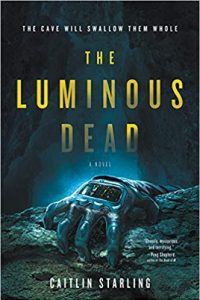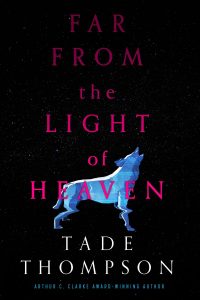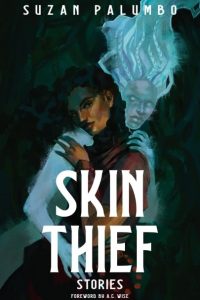Tim Pratt Reviews The Luminous Dead by Caitlin Starling
 The Luminous Dead, Caitlin Starling (Harper Voyager 978-0-06-284690-7, $16.99, 415pp, tp) April 2019.
The Luminous Dead, Caitlin Starling (Harper Voyager 978-0-06-284690-7, $16.99, 415pp, tp) April 2019.
One of my favorite movies is Neil Marshall’s The Descent (2006), about a group of women who enter an unexplored cave system and discover unspeakable subterranean horrors – so when I say Caitlin Starling’s The Luminous Dead is like a science fiction version of The Descent, but even more claustrophobic and harrowing, recognize it as very high praise indeed.
Gyre is a young woman living on a remote planet rich in mineral deposits – and poor in everything else, including quality of life. Gyre’s mother left years ago and never sent back word, and Gyre’s only goal is to make enough money to get off this crappy world and find her mom. The best way to get paid is by charting dangerous cave systems and noting exploitable resources, and Gyre – an experienced spelunker but not a veteran professional – inflates her résumé sufficiently to score a gig doing a solo descent for a powerful company.
These caves are deep, dark, and dangerous. In addition to the challenges of darkness, toxic air, tight squeezes, collapses, and flooded chambers, this planet is home to underground megafauna called tunnelers: think sandworms crossed with the monsters from Tremors. They basically swim through the rock, compressing stone, triggering collapses, and violently attacking any life they encounter. No one’s entirely sure if the tunnelers are just drawn by sound, or if they hunt by smell, or sensing body heat, or all of the above. Explorers like Gyre go down wearing what are basically armored spacesuits, sealed systems with air filters, food supplies (she screws canisters of nutrient goo into the suit that feed directly through a surgical port in her stomach), temperature controls, assorted imaging systems, and an array of built-in medications, stimulants, and sedatives.
The mysterious company that hired Gyre gave her a top-of-the-line suit, but this is no power-armor power-fantasy. The suit serves to add an extra layer of claustrophobia in an already dark-and-tight situation, and worst of all, Gyre doesn’t even have exclusive control of its functions. Her handler, Em, can sedate Gyre, lock the suit’s joints, or otherwise interfere with its functions – including manipulating the visual feeds, which makes Gyre doubt even the evidence of her own eyes. Gyre expected a team of support staff, but instead she just got Em, a cranky, enigmatic, secretive woman who apparently works around the clock alone, sleeping when Gyre sleeps. Their prickly relationship is the heart of the book – a spiky combination of dependence, mutual suspicion, frustration, and fleeting moments of connection.
As Gyre descends deeper into the cave system, she discovers she’s not the first person to explore this system, or even the second, or the third – and that some of those who went down died alone and desperate in the dark. The practical details of Gyre’s journey are heart-thumpingly well done, and I won’t soon forget her swims through submerged chambers full branching dead-ends and hidden tunnels, with vicious cross-currents threatening to pull her off course and strand her forever in a sunless sea. This novel is suspenseful, with more than a few elements of survival horror. Gyre can only carry so many supplies, and while there are staging areas – “camps” – at various depths in the cave, getting to them before her food and batteries run out is often a harrowing race against time… especially when some of the supplies turn out to be missing or damaged, suggesting theft or sabotage. Is someone else down there with her? If so, who are they, and what are their intentions? As if tunnelers, a shady handler, and being trapped in a suit that increasingly feels like a metal coffin with legs isn’t bad enough.
As Gyre descends ever further into the dark (and, if not into madness, then at least into extreme psychological distress), more secrets are revealed. Em is not who she seems, and Gyre’s mission isn’t what she thought it was. The revelation of Em’s true motive, and Gyre’s true purpose, are heartbreaking, and add new depth to a novel that’s already all about going deep. This is a survival story, a psychological thriller, and some of the best SFnal horror I’ve ever read. It’s a hell of a debut, and I can’t wait to see what Starling does next.
In addition to being a senior editor and occasional book reviewer at Locus, Tim Pratt is the author of over 20 novels, most recently space opera The Wrong Stars, first in the Axiom series. His short stories have appeared in The Best American Short Stories, The Year’s Best Fantasy, The Mammoth Book of Best New Horror, and other nice places. He’s a Hugo Award winner for short fiction, and has been a finalist for World Fantasy, Sturgeon, Stoker, Mythopoeic, and Nebula Awards, among others. He lives in Berkeley CA with his family. Every month he writes a new story for his Patreon supporters at www.patreon.com/timpratt
This review and more like it in the September 2019 issue of Locus.
 While you are here, please take a moment to support Locus with a one-time or recurring donation. We rely on reader donations to keep the magazine and site going, and would like to keep the site paywall free, but WE NEED YOUR FINANCIAL SUPPORT to continue quality coverage of the science fiction and fantasy field.
While you are here, please take a moment to support Locus with a one-time or recurring donation. We rely on reader donations to keep the magazine and site going, and would like to keep the site paywall free, but WE NEED YOUR FINANCIAL SUPPORT to continue quality coverage of the science fiction and fantasy field.







